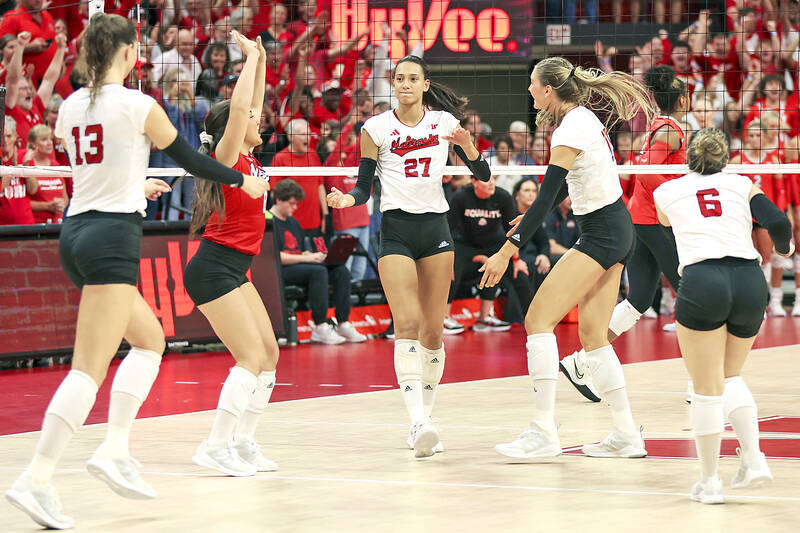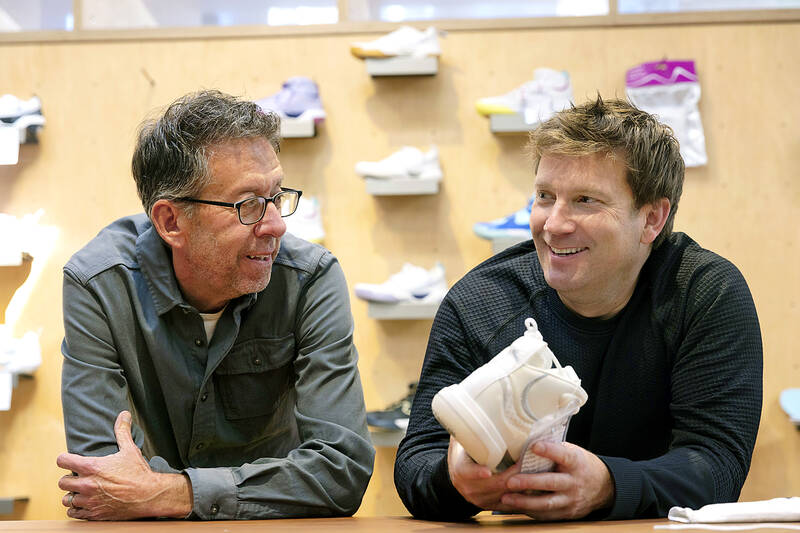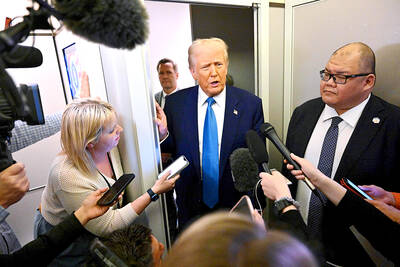Harper Murray puts on her Adidas AG volleyball shoes when she practices or plays in a match for Nebraska, one of the top teams in the country. It is not necessarily the brand she would choose; it is because the German company is her school’s official supplier, and athletes, coaches and staff are required to wear its products.
Texas’ Reilly Heinrich and Virginia’s Ashley Le wear Nike Inc shoes because their schools are under contract with the shoe giant. Heinrich actually wears basketball shoes bearing the familiar swoosh because she says they fit better than Nike’s volleyball shoes.
All three also are brand ambassadors for a new volleyball shoe brand, Avoli, which they promote on social media platforms as part of their name, image and likeness compensation deals with the start-up based in Portland, Oregon, also the hometown of Nike.

Photo: AP
The three can tout Avoli all they want, but it is highly unlikely they would ever wear the brand when they actually represent their schools in competition — a familiar and seemingly immovable hurdle for athletes in many college sports. While they now have the freedom to earn money from name, image and likeness (NIL) endorsements, they remain beholden to terms of apparel contracts paying millions to their schools and nothing to them.
For example, Adidas gives Nebraska US$4.85 million in cash and more than US$6 million in product this year, the seventh in an 11-year contract with a total value of US$128 million.
Murray, the No. 1 high school recruit last year and already one of the top players for the nation’s second-ranked team, said she accepts she must wear Adidas as part of playing for the Cornhuskers.

Photo: AP
“I think if I had the option to wear another shoe, I’d 100 percent pick Avoli,” she said. “Obviously, that’s not really an option.”
College athletes should be able to wear shoes of their choice, said Ramogi Huma, the executive director of the advocacy group College Athletes Players Association.
Limiting athletes to the brand with which their school is affiliated creates two problems, he said. First, it prevents athletes from achieving their full NIL earning potential, because they cannot wear the shoes in competition, when they get the most attention. Second, an athlete’s performance could be compromised if the shoes they are wearing do not fit properly.
“It’s a health and safety issue,” Huma said. “If your foot is being squeezed, that’s a problem. Look at volleyball players. A lot of them are tall, and they may have wider feet than the average person. Everybody is made differently.”
Footwear is an issue in any sport, but the movements associated with volleyball make it critical to have the right fit, Le said.
“Volleyball is one of the most jumping-related sports,” she said. “The shoe — especially with ankle stability and the ability to move laterally and vertically without feeling in danger of hurting yourself — is very important.”
It would be rare for a college athlete to wear a shoe other than the school sponsor’s brand.
For example, the Adidas contract with Nebraska says if an athlete experiences injury, pain or discomfort serious enough to affect performance, Adidas is given an opportunity to remedy the problem. If the problem persists, the athlete can wear another brand, but its logo must be covered.
Nike contracts have similar language. Typically, an independent physician must verify the athlete’s need for an exception.
Missouri in 2021 considered, but did not pass, an amendment to its NIL state law that would have allowed athletes to wear shoes of their choice in mandatory team activities. New Mexico passed a bill last year giving athletes freedom to choose their shoes but that language was removed during this year’s session.
New Mexico Senator Antonio Maestas, one of the original bill’s cosponsors, said he did not know how that happened.
Murray said she has switched between volleyball and basketball shoes over the years.
Heinrich said she wore volleyball shoes she did not really like when she was a high-school and club player and settled on Nike basketball shoes at Texas because she found they gave her foot more support.
Le has worn volleyball shoes since she was little, mainly because she found basketball shoes to be too heavy and wide for her.
The athletic shoe giants all have lines of volleyball shoes, but Avoli cofounders Mark Oleson and Rick Anguilla said their brand is fully dedicated to what they believe is an underserved market.
A feature of the Avoli shoe are tiny holes in the soles to provide ventilation, something young players said they wanted.
Oleson and Anguilla, who have years of experience in various aspects of the athletic shoe business with different brands, declined to criticize their giant competitors.
“Are they making bad volleyball shoes?” Oleson said. “I would say what we’re doing is we’re making a very specific volleyball shoe for the female athlete, how she moves, jumps, squats, pivots, dives and how she’s basically going to live throughout her entire tournament.”
Adidas spokeswoman Sophie LeRoux said in an e-mail that her company’s volleyball shoes are “built with a women’s first approach” and designed in collaboration with professional and amateur players.
Adidas has partnerships with volleyball federations in Europe and China, as well as throughout North America.
LeRoux declined comment on the company’s sponsorship contracts with colleges, while Nike did not respond to messages.
Avoli is content to sell its volleyball products to younger players and is not worried about penetrating the college sponsorship market, Anguilla said.
“With somebody like Harper Murray or any of the athletes we’ve signed to NIL deals, they’re reaching 25, 50, 100,000 people on their social media,” Anguilla said. “When we start thinking about the audience, NIL is going to really impact the value of those all-school contracts long-term. If we can use athletes to bring awareness to our product, and if the product is great, we like that equation.”
That does not help athletes who cannot wear the shoes they would like in competition.
Harper said that she has no problem with Adidas shoes — she just likes the support and feel of her Avolis better.
The matter of shoes is personal to Huma, a former University of California, Los Angeles football player who said he had to have foot surgery in 1996 because of ill-fitting shoes.
Huma said college athletes should get a cut of the revenue from school apparel contracts and that, as partners with the schools, athletes could agree to wear socks, wristbands, headbands and other accessories under those contracts.
Shoes, Huma said, are different because certain brands do not always provide an optimal fit.
“Wearing the same jersey isn’t going to be an issue when it comes to your health,” he said. “Shoes? That matters a lot.”

When an apartment comes up for rent in Germany’s big cities, hundreds of prospective tenants often queue down the street to view it, but the acute shortage of affordable housing is getting scant attention ahead of today’s snap general election. “Housing is one of the main problems for people, but nobody talks about it, nobody takes it seriously,” said Andreas Ibel, president of Build Europe, an association representing housing developers. Migration and the sluggish economy top the list of voters’ concerns, but analysts say housing policy fails to break through as returns on investment take time to register, making the

‘SILVER LINING’: Although the news caused TSMC to fall on the local market, an analyst said that as tariffs are not set to go into effect until April, there is still time for negotiations US President Donald Trump on Tuesday said that he would likely impose tariffs on semiconductor, automobile and pharmaceutical imports of about 25 percent, with an announcement coming as soon as April 2 in a move that would represent a dramatic widening of the US leader’s trade war. “I probably will tell you that on April 2, but it’ll be in the neighborhood of 25 percent,” Trump told reporters at his Mar-a-Lago club when asked about his plan for auto tariffs. Asked about similar levies on pharmaceutical drugs and semiconductors, the president said that “it’ll be 25 percent and higher, and it’ll

NOT TO WORRY: Some people are concerned funds might continue moving out of the country, but the central bank said financial account outflows are not unusual in Taiwan Taiwan’s outbound investments hit a new high last year due to investments made by contract chipmaker Taiwan Semiconductor Manufacturing Co (TSMC, 台積電) and other major manufacturers to boost global expansion, the central bank said on Thursday. The net increase in outbound investments last year reached a record US$21.05 billion, while the net increase in outbound investments by Taiwanese residents reached a record US$31.98 billion, central bank data showed. Chen Fei-wen (陳斐紋), deputy director of the central bank’s Department of Economic Research, said the increase was largely due to TSMC’s efforts to expand production in the US and Japan. Investments by Vanguard International

WARNING SHOT: The US president has threatened to impose 25 percent tariffs on all imported vehicles, and similar or higher duties on pharmaceuticals and semiconductors US President Donald Trump on Wednesday suggested that a trade deal with China was “possible” — a key target in the US leader’s tariffs policy. The US in 2020 had already agreed to “a great trade deal with China” and a new deal was “possible,” Trump said. Trump said he expected Chinese President Xi Jinping (習近平) to visit the US, without giving a timeline for his trip. Trump also said that he was talking to China about TikTok, as the US seeks to broker a sale of the popular app owned by Chinese firm ByteDance Ltd (字節跳動). Trump last week said that he had